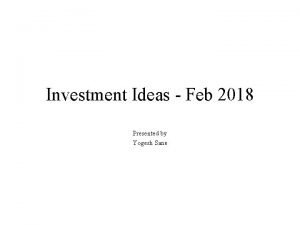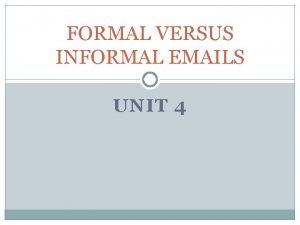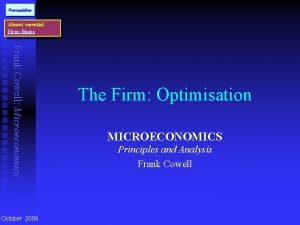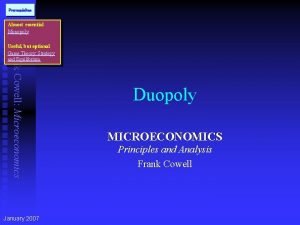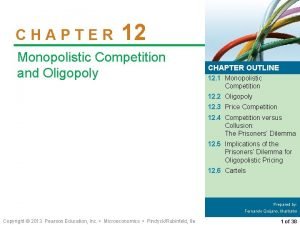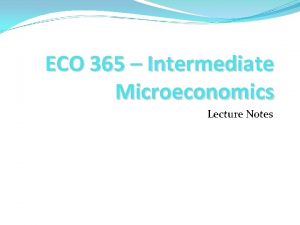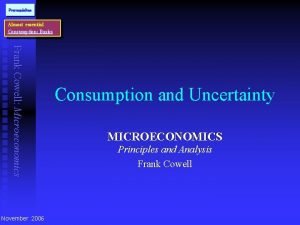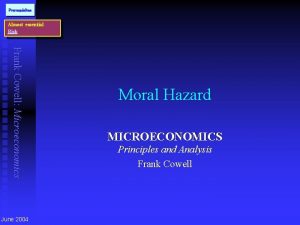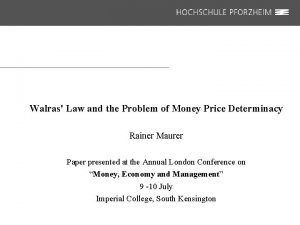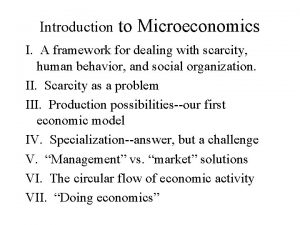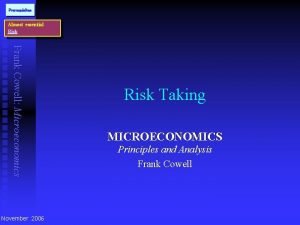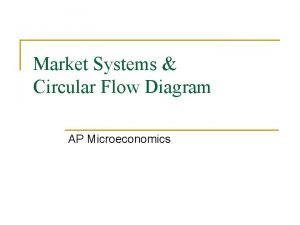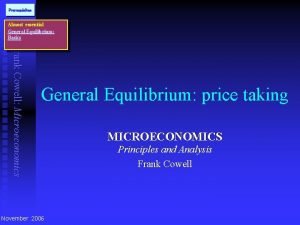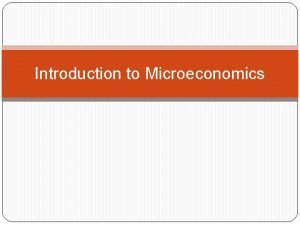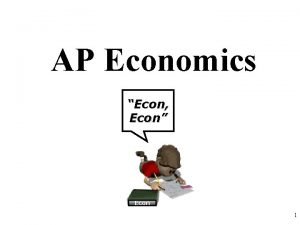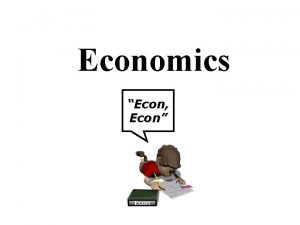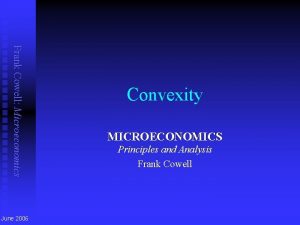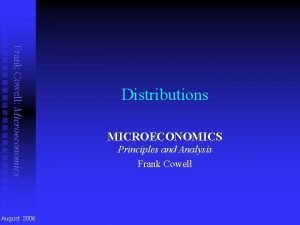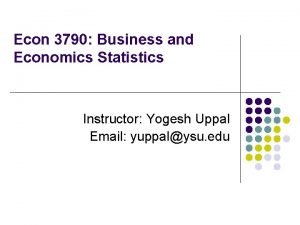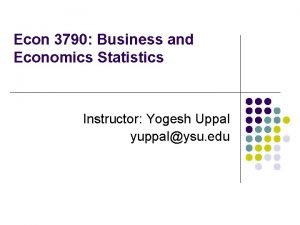Econ 2610 Principles of Microeconomics Yogesh Uppal Email




























- Slides: 28

Econ 2610: Principles of Microeconomics Yogesh Uppal Email: yuppal@ysu. edu

Chapter 4 Elasticity

Drug Enforcement and Local Theft l Hypothesis l l l Drug users steal to buy drugs Increase drug enforcement will decrease theft Analysis l Increased enforcement reduces supply of drugs l l l Price of drugs increases Quantity demanded decreases Theft goes down ONLY IF total expenditures on drugs decreases l How responsive is quantity demanded to price?

Price Elasticity of Demand l Price elasticity of demand l l l Percentage change in quantity demanded from 1% change in price Measure of responsiveness of quantity demanded to changes in price Example l l l Price of beef decreases 1% Quantity of beef demanded increases 2% Price elasticity of demand is – 2 P Q

Calculate Price Elasticity l For small percentage changes in price ε= Percentage change in quantity demanded Percentage change in price § Price elasticity of demand is always negative § Ignore the sign

Elastic Demand Price Elasticity of Demand Unit elastic Elastic Inelastic 0 l 1 2 3 If price elasticity is greater than 1, demand is elastic l Percentage change in quantity is greater than percentage change in price l Demand is responsive to price

Inelastic Demand Price Elasticity of Demand Unit elastic Elastic Inelastic 0 l 1 2 3 If price elasticity is less than 1, demand is inelastic l Percentage change in quantity is less than percentage change in price l Quantity demanded is not very responsive to price

Unit Elastic Demand Price Elasticity of Demand Unit elastic Elastic Inelastic 0 l 1 2 3 If price elasticity is 1, demand is unit elastic l Price and quantity change by the same percentage

Example: Demand for Pizza Price Quantity ε= ε= Old New $1. 00 400 $0. 97 404 % Change 3% 1% Percentage change in quantity demanded Percentage change in price 1% 3% = 0. 33 Demand is inelastic

Determinants of Price Elasticity of Demand Substitution Options • More options, more elastic • Salt • Morton's salt Budget Share • Large share, more elastic • New car • Salt Time • Long time to adjust, more elastic • Air conditioner • Gasoline

Examples of Elasticities Green peas Restaurant meals Beer Coffee Automobiles Foreign air travel 2. 80 1. 63 1. 19 0. 25 1. 35 0. 77 Movies 0. 87 Theater, opera 0. 18

Price Elasticity Notation l ΔQ is the change in quantity l l ΔQ / Q is percentage change in quantity ΔP is change in price l ΔP / P is percentage change in price ε= ΔQ / Q ΔP / P

Price Elasticity on a Straight. Line Demand Curve l Price elasticity is different at each point ε= l l P Q x 1 slope Slope is the same for the demand curve P/Q decreases as price goes down and quantity goes up

Price Elasticity Pattern l l Price elasticity changes systematically as price goes down At high P and low Q, P / Q is large l At the midpoint, demand is unit elastic At low P and high Q, P / Q is small Price l Demand is elastic l l Demand is inelastic a a/2 b/2 Quantity b

Two Special Cases l Perfectly Elastic Demand Infinite price elasticity of demand l Price Perfectly Inelastic Demand Zero price elasticity of demand Price D D Quantity

Elasticity and Total Expenditure l l l When price increases, expenditures can increase, decrease or remain the same l The change in expenditures depends on elasticity Terminology: total expenditures = total revenue l Calculate as P x Q Price Graphing idea: total Expenditures = 8 expenditures is the area of a rectangle with height P and width Q 2 l Example: P = 2 and D Q=4 4 Quantity

Price Elasticity and Total Expenditure Movie ticket price increases from $2 to $4 A and B are both below the midpoint of the curve l l Inelastic portion of the demand curve Total revenue increases when price increases 12 D 12 Expenditure = $1, 000/day Price ($/ticket) l A 2 5 6 Quantity (00 s of tickets/day) D Expenditure = $1, 600/day B 4 4 6 Quantity (00 s of tickets/day)

Price Elasticity and Total Expenditure Movie ticket price increases from $8 to $10 Prices are both above the midpoint of the curve l l Elastic portion of the demand curve Total revenue decreases 12 8 Y Expenditure = $1, 600/day D 2 6 Quantity (00 s of tickets/day) Price ($/ticket) l 12 10 Z Expenditure = $1, 000/day D 1 6 Quantity (00 s of tickets/day)

Price Changes and Total Expenditure Changes Price $10 $8 $6 $4 $2 $0 Quantity 0 1, 000 2, 000 3, 000 4, 000 5, 000 6, 000 Expenditure $0 $1, 000 $1, 600 $1, 800 $1, 600 $1, 000 Total expenditure ($/day) $12 12 Price ($/ticket) 10 8 6 4 2 1 2 3 4 5 6 Quantity (00 s of tickets/day) $0 1, 800 1, 600 1, 000 2 6 Price ($/ticket) 10

Elasticity, Price Change, and Expenditures

Cross-Price Elasticity of Demand l l Substitutes and complements affect demand Cross-price elasticity of demand l l Percentage change in quantity demanded of A from a 1 percent change in the price of B Sign of cross-price elasticity shows relationship between the goods l l Complements have negative cross-price elasticity Substitutes have positive cross-price elasticity

Income Elasticity of Demand l Income elasticity of demand l l Percentage change in quantity demanded from a 1 percent change in income Income elasticity of demand can be positive or negative l l Positive income elasticity is a normal good Negative income elasticity is an inferior good

Price Elasticity of Supply l Price elasticity of supply l Percentage change in quantity supplied from a 1 percent change in price Price elasticity of supply = P Q ΔQ / Q ΔP / P x 1 slope

Price Elasticity of Supply If supply curve has a positive intercept Price elasticity of supply decreases as Q increases Graph shows l Slope = 2 l At A, P = 8 and Q = 2 l l § l B 10 8 A 4 Price elasticity of supply = (8 / 2) (1 / 2) = 2. 00 At B, P = 10 and Q = 3 § S Price l Price elasticity of supply = (10 / 3) (1 / 2) = 1. 67 2 Quantity 3

Perfectly Inelastic Supply l Zero price elasticity of supply l l No response to change in price Price l Supply Any one-of-a-kind item has perfectly inelastic supply l Work Quantity is completely fixed l S Example: land on Manhattan of art (Mona Lisa) l Hope Diamond

Perfectly Elastic Supply § Infinite price elasticity of supply § Sell all you can at a fixed price Price S Quantity § Inputs purchased at a constant price § No volume discounts § Constant proportions of production § Lemonade example § Cost of production is 14¢ at all levels of Q § Marginal cost P = 14¢

Determinants of Price Elasticity of Supply Input Flexibility Mobility of Inputs • Uses adaptable inputs, more elastic • Resources move where needed, more elastic Produce • Alternative inputs easy to find, Substitute Inputs more elastic Time • Long run, more elastic

Supply Bottleneck: Unique Inputs l Over time, most producers develop alternative production methods and a variety of input choices l l The more flexible the production process, the more elastic supply When production relies on a single input, supply is highly inelastic l No alternatives to singular talent l l l Sports stars Actors and musicians Bill Gates, Warren Buffet, George Soros, Carl Icahn
 Polluter
Polluter Yogesh uppal
Yogesh uppal Econ
Econ Yogesh uppal
Yogesh uppal Yogesh sane
Yogesh sane Yogesh kalyani
Yogesh kalyani Pavan uppal
Pavan uppal 22 rents
22 rents Email format formal
Email format formal System of national accounting
System of national accounting Almost essential
Almost essential Microeconomics examples
Microeconomics examples Examples microeconomics
Examples microeconomics Cowell microeconomics
Cowell microeconomics Microeconomics
Microeconomics Cartel microeconomics
Cartel microeconomics Intermediate microeconomics notes
Intermediate microeconomics notes Cowell microeconomics
Cowell microeconomics Microeconomics chapter 12
Microeconomics chapter 12 Macroeconomics michael parkin 13th edition
Macroeconomics michael parkin 13th edition What is the subject matter of microeconomics
What is the subject matter of microeconomics Almost essential
Almost essential Microeconomics
Microeconomics Roger guesnerie
Roger guesnerie Microeconomics ia
Microeconomics ia Cowell microeconomics
Cowell microeconomics Circular flow model microeconomics
Circular flow model microeconomics Definition of macroeconomics
Definition of macroeconomics Almost essential
Almost essential




